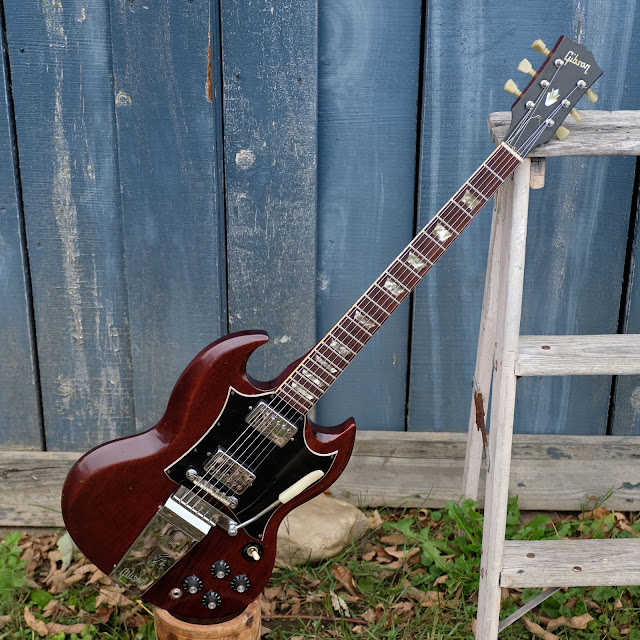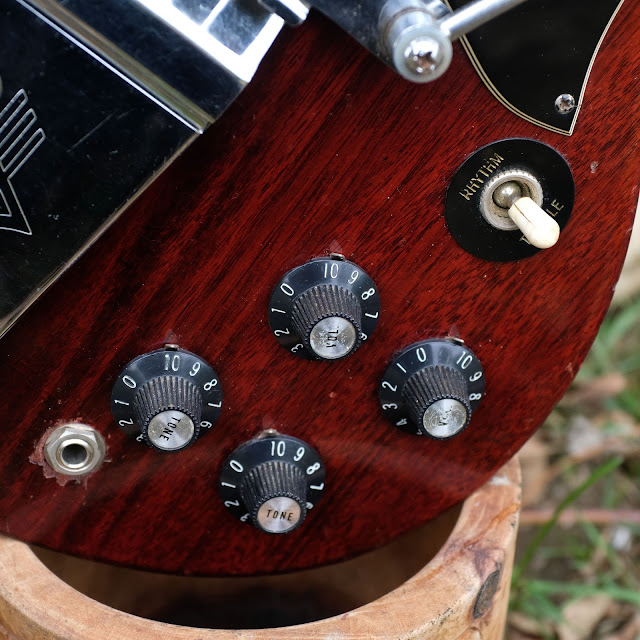1968 Gibson SG Standard Electric Guitar
A friend of mine owns this SG and dang -- it's a beaut! As you might expect, it plays effortlessly and "turns on a dime." Something about the lightweight build, curvy contours, and absurd fret access makes playing these guitars very un-limiting. You don't feel tied in your playing to the limitations of the design so much.
This guitar appears to be almost entirely original, though I do have questions regarding oversized holes for the bridge posts in the pickguard and I myself replaced a badly-worn-out (literally!) original jack with a new Switchcraft one. Other work of mine included a fret level/dress, cleaning, and a good setup with fresh 46w-10 strings. It plays spot-on with a straight neck, working truss-rod, and a good amount of life left in the low/wide original Gibson fretwire. Action is hair-under 3/32" EA and 1/16" DGBE at the 12th fret.
There's an old repair to the neck-joint area, too. While the neck itself wasn't split, the sidewalls of the body where the neck joint runs into the body have repaired cracks on either side of the neck where the joint must've given way and taken them with it. In addition, someone added dowel-reinforcement into the end of the neck itself. This is all very well done and both the guitar and neck are in good order and the neck angle is good. Otherwise the guitar is pretty dang clean with only one small crack in the pickguard (to the bass side of the neck pickup at the screw location), one bigger ding-out on the back of the neck, and general use-wear and finish crackle throughout.
Specs are: 24 5/8" scale, 1 9/16" nut width, 1 7/16" string spacing at the nut, 2" spacing at the bridge, 13 1/4" lower bout, 11" upper bout, and ~1 3/8" side depth.
Woods are: solid mahogany body and neck, rosewood fretboard.
I love it when the clearcoat yellows over pearl and then flakes-off here and there over time. It's like verdigris on copper for me.
While the saddles are maxed-out to the rear of the bridge, the guitar plays in-tune. I nudged the compensation a little on the G-string saddle insert itself to get it right.
All the wiring is in good order.
Let's not forget the Maestro-style Vibrola tailpiece.
Here's that bigger ding on the back of the neck.
The original case is in good shape except for...
...some damage near the tailpiece area of the side.
OK, let's do the "pickguard-removed" shots. Here you can see the neck joint/body stuff going on.
Note the dowels running into the butt of the neck.
Here's the rear side of the pickups.
The pickguard seems to be original to me, so I'm guessing the oversize holes near the bridge post sockets were cut to allow further travel of the bridge adjusters...?
The above shot is of the stock wiring. The original (panel-style) jack was in bad shape and its barrel was actually just worn-out too large. It thus wasn't holding well and crackled like mad.
I'm guessing this Paul Mantz isn't the famous air-racing pilot?
Here's the new Switchcraft jack installed and some duct-tape covering the surface of the shielding pan just in case the jack spins (as it's seemed to have done judging by the wear on top of the guitar) and grounds-out the spring-clip by accident.







































Comments